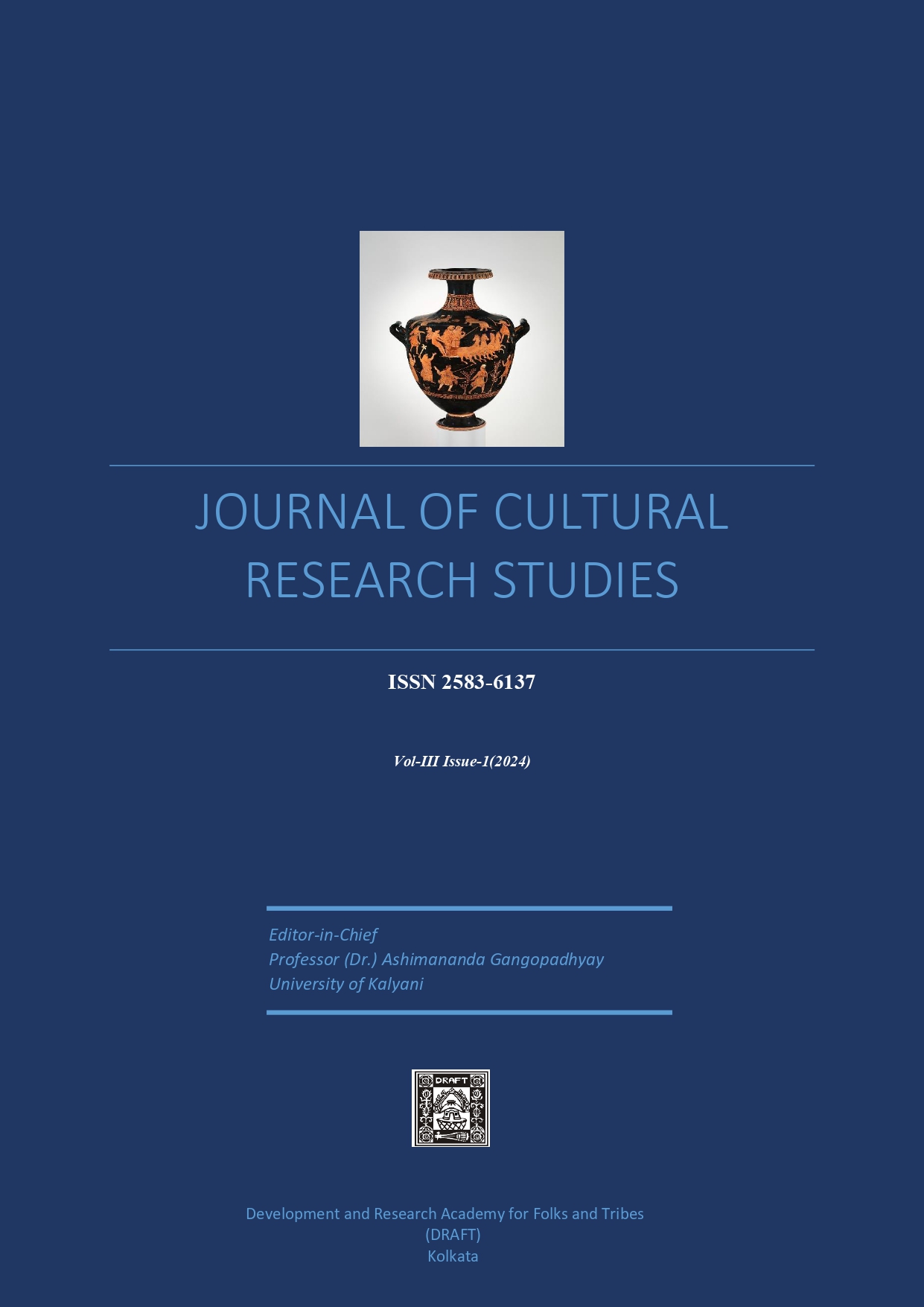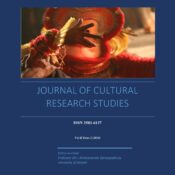
Volume III Issue I
Editorial statement: Volume III Issue 1 (2024) of Journal of Cultural Research Studies (ISSN:2583-6137) is published after a hectic process of Blind Peer Review and Plagiarism checking by iThenticate software for few months. Articles have been submitted by scholars on different subjects, fields like Sociology, History, Literature, Folklore, Indian Classical History, Film studies, Linguistics, Myth, etc from different parts of India and abroad. ... Articles as diverse as these have to be Blind Peer Reviewed by experts, which has been a really difficult task for the editors. Many articles have to be refused on the basis of Peer Review and Plagiarism Similarity Reports. We feel sorry for those articles. It feels a profound gratification after selecting and many stages of proof-corrections, Journal of Cultural Research Studies (ISSN:2583-6137) has been finally published. It is expected that these articles will seriously contribute towards social and humanities research.
This article examines contemporary social welfare schemes in relation to the age-old communal living of the indigenous people of Esan in Edo State of Nigeria. It establishes through specific examples that right from time immemorial the people had established models of helping one another in every facet of their lives. ... The study used ethnographic method which includes the interview, observational technique and group discussion in eliciting data. It was found that modern living occasioned by Christianity and other forces of acculturation has impinged on their traditional lives which is fast eroding their collective lifestyles. While cultural dynamism cannot be ruled out or is it possible to halt cultural borrowing and adaptation of cultures, the speed at which Esan belief systems are fading is disturbing. Consequently, the core values of the people should be reenacted and preserved the government, its agencies and traditional rulers as custodians of the people’s culture.
জনসাধাৰণৰ নিভাঁজ মনৰ মধুৰ ভাৱৰাজিৰ মুকলিভাৱে প্ৰকাশ কৰিব পৰা মাধ্যমটোৱেই হৈছে লোকগীত।প্ৰৱাহমান গতিৰে মানৱ সমাজত প্ৰচলিত হৈ থকা সামাজিক প্ৰথাটো হৈছে বিয়া বা বিবাহ।অসমীয়া জাতীয় জীৱনত প্ৰভাৱ বিস্তাৰ কৰা সংস্কৃতিৰ পথাৰখনিত বহুতো উৎসৱ-পাৰ্বন,ৰীতি-নীতি,সামাজিক লোকাচাৰ প্ৰচলন।এই সমূহৰ ভিতৰত বিবাহ পৰম্পৰাটো অন্যতম। ... বিবাহত প্ৰচলিত গীত-মাত বোৰকেই বিয়ানাম বুলি জনা যায়।বিয়ানামৰ প্ৰচলন অতি পুৰণি। বিয়ানামবোৰ অসমৰ জাতীয় জীৱনৰ এক অমূল্য সম্পদ তথা অসমীয়া লোকগীত আৰু লোকসাহিত্যৰ আপুৰুগীয়া সম্পত্তি।অসমীয়া বিবাহ অনুষ্ঠানৰ কোমলতা আৰু অনুভূতিৰ লগতে অবাৰিত কল্পনা শক্তি,চিন্তাৰ গভীৰতা আৰু মনোৰম প্রকাশভংগী আদি বিয়ানামবোৰতে পোৱা যায়।অসমীয়া ভাষীসকলৰ উপৰিও অন্যান্য জনগোষ্ঠীসমূহৰ মাজতো এই পৰম্পৰা প্ৰচলিত। সমাজ এখনৰ বাবে দাপোণস্বৰূপ হৈছে সেই সমাজখনৰ সংস্কৃতি।ইতিহাসৰ পাত লুটিয়ালে অনুমান কৰিব পাৰি আজিও এক অনুপম ৰূপত প্ৰতিভাত হৈ আছে অসমীয়া নাৰীয়ে অসমৰ ঐতিহ্য পৰম্পৰা ৰক্ষাৰ ক্ষেত্ৰত আগবঢ়োৱা উল্লেখযোগ্য ভূমিকাৰ কথা।আদিম কালৰে পৰা সংস্কৃতিৰ পথাৰখনত নাৰীৰ অৱদান উল্লেখনীয়।অসমীয়া বিবাহত প্ৰচলিত প্ৰায় সকলো লোকাচাৰেই নাৰীকেন্দ্ৰিক।নাৰী আৰু পুৰুষ এটা মুদ্ৰাৰ ইপিঠি সিপিঠি।যেনেকৈ ইয়াৰ যৌথ প্ৰচেষ্টাত সমাজ একোখন চলে ঠিক সেইদৰে,অসমীয়া লোকসংস্কৃতি ভৰাঁলটোৱেও আমাক মেটমৰা কৰি ৰখাত সহায় কৰিছে।ইয়াৰে এক নিৰ্দশন হৈছে অসমীয়া নাৰীৰ কণ্ঠত প্ৰাণপোৱা এক চিৰসেউজ গীত "বিয়ানাম"।এই নামত পৰিস্ফুট হৈছে অসমীয়া নাৰীয়ে সমাজ নিয়ন্ত্ৰণ,সমাজীকৰণ,সমাজ সংহতকৰণ আদি বিভিন্ন দিশত পুৰুষৰ সৈতে সহযোগিতা আগবঢ়াই মূখ্য ভূমিকা পালন কৰাৰ দৃশ্য।নাৰীসুলভ কোমলতা আৰু অনুভূতি প্ৰৱণতাৰ বাবেই বিয়া উৎসৱৰ বিভিন্ন কাৰ্য ক্ৰমণিকাত বিয়ানামৰ ৰচয়িত্ৰী সকলে স্বকীয় কবিত্বশক্তিৰে বিধে বিধে গীত ৰচনা কৰি প্ৰতিভাৰ নিদৰ্শন দাঙি ধৰা দেখা পোৱা যায়।এক কথাত ক’বলৈ গ’লে নাৰীমনস্তত্ত্ব আৰু নাৰীজীৱনৰ বিচিত্ৰ চিত্ৰণ প্ৰতিফলন ঘটিছে এই বিয়ানামৰ মাজেদি।বৰ্তমান অসমত বিলুপ্তিপথেৰে গৈ থকা বিয়ানামবোৰৰ সমল নিয়ত ৰক্ষয়িত্ৰী হিচাপে বিবেচিত এক বৃহৎ সংখ্যক নাৰীৰ ছবিখন আগত ৰাখি আৰু লগতে অসমীয়া সংস্কৃতিত নাৰীৰ ভূমিকা ও অৱদান তাৰ প্ৰতি লক্ষ্য ৰাখি "বিয়ানামত অসমীয়া নাৰীৰ জীৱন" এই বিষয়টোৰ ওপৰত অৱলোকন কৰা হৈছে।
A comparative study of The Ramayana and The Iliad in terms of narratological theories will certainly yield rewarding results. Narratology has been developed from the tradition of story-telling which is seen as a universal cultural phenomenon. From Classical narratology to Post Classical narratology, theories and beliefs of narrative techniques, insights have been explored ... with multidisciplinary and trans-generic applications in epics, novels, lyrics, fictions to non-fictions. A comparative study of selected portions of The Ramayana and The Iliad in terms of Focalisation, Narrative motive, Mimetic and Diegetic narration can yield rewarding results if narratological ideas are minutely applied. It will certainly explore the oral and literary traditions of the two great Occidental and Oriental epics in terms of their narrative technique.
This paper examines the pivotal role of cultural dimensions in fostering unity for Tamil linguistic minorities in diverse environments. Cultural factors serve as a multifaceted lens through which individuals and communities interpret the world, interact, and construct shared identities. By exploring these cultural dimensions, this study provides valuable insights into the mechanisms that ... either facilitate or hinder social integration within Tamil linguistic minority communities. Understanding and leveraging cultural dynamics are essential for promoting cohesion and inclusivity in multicultural settings. Additionally, this paper sheds light on the impact of transnationalism and generational shifts on cultural adaptation, emphasizing the importance of embracing diversity while preserving distinct cultural identities for fostering resilience and inclusivity in multicultural societies.
In the Hindu Bengali society during the Brata performances, goddesses are worshipped by the womenfolk without a priest and they themselves recite kathas or conventional stories, written in Bengali rather than in Sanskrit. Despite the fact that these kathas have ‘no noticeable logical build-ups’ (Spivak 2001), the brota-katha is still in practice, followed and is recited in majority of ... the Bengali households. This paper questions the relevance and persistence of the above practice vis-a-vis contemporary modernizing forces of women empowerment, gender equality, and financial independence of women.
Beyond the notion of food as a basic need, there is lot to uncover. It can turn a housewife into successful businesswomen and bring a ray of hope for financial independence. But, are always the motivations behind starting business same? How do the so called inspirations execute the whole journey? Because, becoming a foodpreneur may not be the dream for everyone. Each and every ... person has their own reason behind the beginning. It may be out of passion or out of boredom. Some of them might have compelled to choose this path to overcome a crisis etc. Therefore, the essay is a small endeavor to penetrate the back stage scenario of foodpreneurship in a (Mofussil Definition & Meaning - Merriam-Webster, n.d.)moffusil area of North Bengal(North Bengal Tourism - Official Website - North Bengal, n.d.) i.e. Alipurduar District.
The Indian handicraft has a 5000-year-old history and can be traced from the Indus Valley civilization period. From that time Indian handicrafts evolved into various forms. It not only accelerated on its own but it adopted so many outer things, when the colonial period started in this country the craftsmen and their art tried to adopt the taste of their foreign ... colonial masters and successfully made fusion handicrafts. If we divide the periods of the handicrafts of this country, we can say there are mainly three eras of Indian handicrafts, ancient, medieval, and modern, we can also say the pre-British era, the British colonial era, and the post-British colonial era. In this paper, we will elaborate on these periods and we will also discuss specifically a little about Bengal’s handicraft market and try to create a deeper understanding of the history and heritage of the Indian handicrafts and its market.
'আনন্দাদ্ধ্যেব খল্বিমানি ভূতানি জায়ন্তে' আনন্দ ছাড়া কোনো জীবই বাঁচতে পারে না। সভ্য বা অসভ্য যে জাতিই হোক না কেন তাদের আনন্দ ও ফুর্তির প্রকাশ- উৎসব, ক্রীড়া-কৌতুক ও নৃত্য-গীতের মাধ্যমে হয়ে থাকে। শিশুরাও জাগরণে যেমন হাত পা ছোঁড়ে, স্বাদু আওয়াজ করে, নানা রকম খেলা করে, ঘুমিয়ে ঘুমিয়েও তারা 'দেয়ালা' করে। কিশোর-কিশোরী, যুবক-যুবতী, প্রৌঢ়-প্রৌঢ়া, বৃদ্ধ-বৃদ্ধা, জাতি-ধর্ম-বর্ণ-গোত্র নির্বিশেষে আমোদ বা বিনোদনে অংশ নেয়। বয়সের সঙ্গে সঙ্গে আমোদের ধরন পালটায়। ... গ্রাম, নগর, অরণ্য পার্বত্যাঞ্চলে এইসব বিনোদনের রকম আলাদা। কোনো বিনোদন নগরে জন্ম নিয়ে গ্রামে ঠাঁই নিয়েছে। আবার কোনোটা গ্রাম থেকে শহরে এসেছে। কারো কারো অবস্থান শহর ও গ্রাম দুই স্থলেই। কতক বিনোদন গুপ্ত, অপ্রকাশ্য আবার কতক প্রকাশ্য-সর্বজনীন। বিনোদনের জন্ম ধর্মাধর্ম ও কর্মাবকাশের কারণে। অনেক প্রথা-আচারই তো বিনোদন। যেমন- আদিবাসীদের শিকার পরব। গান, নাচ, নৃত্য-গীত, পাঠ, পশুপাখির লড়াই, গল্পগাছা, খেলাধুলা এবংবিধ বিনোদন সবই সামাজিক, ধর্মীয়, পরিবেশগত, ইতিহাস ও আর্থিক কারণে সৃষ্ট। ধর্মীয় আচার ও প্রচার বিনোদনের এই দুটি দিক। জাতিগত, ধর্মগত, গোষ্ঠীগত ও ব্যক্তিগত নানান বিনোদনের বৈচিত্র্য যুগে যুগে কালে কালে মানুষকে আকৃষ্ট করেছে।যুগে যুগে বিনোদনের পরিবর্তন, পরিবর্ধন, পরিমার্জন হয়েছে। গ্রামীণ বিনোদনকে পিছনে ফেলে যুক্ত হয়েছে এফ. এম, টেলিভিশন,পাশাপাশি ভিডিও গেম, সোশ্যাল মিডিয়ার হরেক কিসিমের বিনোদন। তবু ফেলে আসা গ্রামের আনন্দ অনুষ্ঠানের কোন তুলনা হয় না। এর মূল্য চিরকালীন।
এই গবেষণাধর্মী নিবন্ধে আলোচিত হয়েছে সাঁওতাল সমাজের ‘ডাইনি প্রথা’ নামক একটি অন্ধবিশ্বাস। ‘ডাইনি প্রথা’ আমাদের সভ্যতাকে চ্যালেঞ্জ জানায়। কেন এই ডাইনি ? এ কি কেবল এক কুসংস্কার, না এর পরতে পরতে আছে আর্থ সামাজিক জগদ্দল পাথর। এই প্রথার জন্য বহু সাঁওতাল মহিলাকে অসহায় ভাবে মৃত্যুবরণ করতে হয়। সাঁওতালরা এখনও শহরাঞ্চল থেকে অনেক দূরে বসবাস করেন। ফলে সেরকম ভাবে শিক্ষার আলো পায়না। ... তাদেরকে দারিদ্র্যতার মধ্যে দিয়ে জীবন কাটাতে হয়। দারিদ্র্য এবং মূলত শহরাঞ্চল থেকে অনেক দূরে বসবাস করার জন্য ভালো চিকিৎসা ব্যবস্থা পায়না। ফলে তাদেরকে ‘জানগুরু’ অর্থাৎ ওঝার উপর নির্ভরশীল হয়ে থাকতে হয়। সাধারণ রোগে ‘ওঝার’ দেওয়া শিকড়-বাকড়, মন্ত্র, জলপড়া ইত্যাদি দিয়ে উপশম পাওয়া গেলেও জটিল বা দূরারোগ্য ব্যাধি তাতে সারে না। আর তখনই ওঝারা নিজেদের অস্তিত্ব বজায় রাখতে আশ্রয় নেন কল্পিত সব অতিপ্রাকৃত শক্তির। দূরারোগ্য ব্যাধি উপশম না হবার পিছনে নাকি ‘ডাইনি’দের হাত আছে। এমন কথা বলতে থাকেন ‘জানগুরু’ অর্থাৎ ওইসব ওঝার দল। এইসব ওঝার কুদৃষ্টির ফাঁদে পড়লে আর কোনো নিস্তার নেই। আজ নয়তো কাল ‘ডাইনি’ অপবাদে দন্ডিত হতে বাধ্য।




